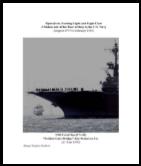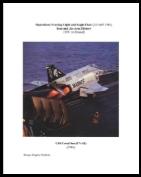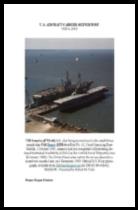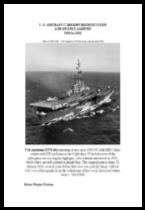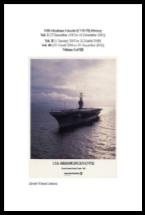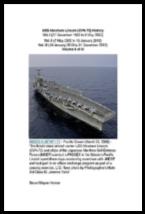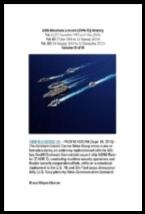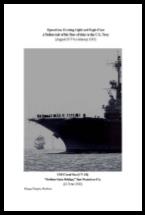




|
A Sailors tale of his Tour of duty in the U.S. Navy (August 1977 to February 1983) Operation Evening Light and Eagle Claw - 4 April 1980
Book - ISBN NO. 978-1-4276-0454-5 EBook - ISBN NO. 978-1-329-15473-5
Operations Evening Light and Eagle Claw (24 April 1980) Iran and Air Arm History (1941 to 1980)
Book ISBN NO. xxxxxxxxxxxxx EBook ISBN NO. 978-1-329-19945-3
U. S. AIRCRAFT CARRIER SHIP HISTORY (1920 to 2019)
Book - ISBN NO. 978-1-4276-0465-1 EBook - ISBN NO. 978-1-365-25019-4 Library of Congress Control Number: 2008901616 (Book Version)
U. S. AIRCRAFT CARRIERS REDESIGNATED AND OR RECLASSIFIED (1953 to 2016)
BOOK - ISBN NO. 978-1-4276-0452-1 EBook - ISBN NO. 978-1-365-25041-5 Library of Congress (Book Version) 2008901619
ENERGY QUEST AND U. S. AIRCRAFT CARRIER DEPLOYMENT HISTORY INVESTMENT CAPITAL REQUIRED TO PUBLISH 55 EIGHTH HUNNDRED PAGE BOOKS, EBOOKS & CD’s (48 Navy Books)
Book - ISBN NO. To Be Announced EBook - ISBN No. 978-1-365-26038-4
USS Abraham Lincoln (CVN-72) History Vol. I of III (27 December 1982 to 6 May 2003)
Book Vol. I of IV ISBN: TBA EBook Vol. I of IV ISBN: 978-1-365-73794-7
USS Abraham Lincoln (CVN-72) History Vol. II of III (7 May 2003 to 13 January 2010)
Book - ISBN NO. To Be Announced EBook - ISBN NO. 978-1-365-74027-5
USS Abraham Lincoln (CVN-72) History Vol. III of III (14 January 2010 to 31 December 2012)
Book - ISBN NO. To Be Announced EBook - ISBN No. 978-1-365-74145-6
USS Coral Sea CV-42 CVB-43 CVA-43 and CV-43 History and Those Aircraft Carriers Operating with Coral Sea During Her Tour of Service CONSTRUCTION to LAUNCHING and EARLY JET AIRCRAFT DEVELOPMENT (10 July 1944—2 April 1946) and a Tour of Duty in the U. S. Navy (August 1977 to February 1983)
ISBN: 9781434382917
|

|
An overhead view of the flight decks of the aircraft carriers USS Independence (CV-62), top, and USS Midway (CV-41), bottom, moored beside each other, Naval Station Pearl Harbor, 23 August 1991. A great detailed photo, showing the various aircraft of their Air Wings. Midway was en route from Naval Station, Yokosuka, Japan, to Naval Air Station, North Island, California, where she would be decommissioned in the spring of 1992. Independence would travel to Yokosuka to take over as the Navy's only forward-based aircraft carrier. US Navy photo by PH2 Omar Hasan. (Available from DefenseImagery.mil as photo # DN-ST-9203042.) - NS026252 - Robert M. Cieri. http://www.navsource.org/archives/02/026252.jpg |


|
Table of Contents, Part 1 of 3 (11 September 1945 to 10 September 1973) |
|
USS Midway (CVB-41) Approved by Congress in July 1942, Construction, Launching and Commissioning CVB-41, the lead ship of the Midway class, was ordered on August 7, 1942. Construction of a large carrier was approved by Congress in July 1942 and the first fleet carrier to have the distinction of being named after a WWII battle. (July 1942 to 10 September 1945) CHAPTER I
“The board had held hearings on the proposed “battle” carrier as early as March 1942” (Ref. 1083).
“The carrier battle of Midway Island in June 1942 turned the tide of World War II and proved conclusively the potential of naval aviation. CVB-41 was the third American ship and the second aircraft carrier to bear the name of Midway.
The carrier battle of Midway Island in June 1942 turned the tide of World War II and proved conclusively the potential of naval aviation. CVB-41 was the third American ship and the second aircraft carrier to bear the name of Midway” (Ref. 1082).
The Midway is named for the Battle of Midway, fought on June 3-6, 1942, when Japanese offensive action was brought to an end and the balance of naval power was restored in the Pacific. The battle is considered the naval turning point of the war against Japan. A strong Japanese thrust to occupy Midway Island was led by a four-carrier Striking Force, supported by heavy units and destroyers. At the same time, another carrier raid was launched against Dutch Harbor in the Aleutian Islands. The Japanese attack on Midway was met by a three-carrier U.S. force:
Task Force 17—RADM Fletcher—with USS Yorktown (CV-5) and Task Force 16—RADM Spruance—with USS Enterprise (CV-6) and USS Hornet (CV-8). In the ensuing battle, the four large Japanese carriers (Akagi, Hiryu, Kaga and Soryu) were sunk, carrying with them 250+ planes along with a high number of Japan's most highly trained and battle-experienced pilots and ground crews, a blow to Japan from which she could not recover. Midway was a crucial point of the war in the Pacific. Photo: SBD Dauntless dive bombers from Hornet approaching the burning Japanese heavy cruiser Mikuma to make the third set of attacks on her, during the early afternoon of 6 June 1942. Mikuma had been hit earlier by strikes from Hornet and Enterprise leaving her dead in the water and fatally damaged. Photo was enlarged from a 16mm color motion picture film. Note bombs hung beneath these planes. Official U.S. Navy Photograph, now in the collections of the National Archives (#80-G-17054). NS024196. http://www.navsource.org/archives/02/024196.jpg
“Midway, an atoll of two islands at the northwest tip of the Hawaiian Islands Chain, was saved to become an important submarine base for operations into the western Pacific. Likewise saved was Hawaii, the great bastion from which attacks were carried into the South Pacific and Japan itself. Of greatest importance was the crippling of Japan's carrier striking force, a severe blow from which she never recovered. With four large aircraft carriers and a cruiser at the bottom of the sea went some 250 planes along with a high percentage of her most highly trained and battle experienced carrier pilots. The great victory in the Battle of Midway spelled the doom of Japan” (Ref. USS MIDWAY Command History for Calendar Year 15 December 1945).
“The Midway is the third American ship to bear the name, and the second one named after the pivotal Battle of Midway (3–6 June 1942)” (Ref. 1082 & USS MIDWAY Command History for Calendar Year 15 December 1945).
“Construction of a large carrier was approved by Congress in July 1942” (Ref. 1082).
The Midway class would have a convoluted history. In August 1942, Secretary of the Navy Frank Knox approved contract awards for the fiscal 1943-1944 authorization of 690 new ships including four large carriers, CVB-41 thru 44. The outset of World War II saw a progression of American aircraft carrier design leading to larger and more heavily armored battle carriers. CVB-41, the lead ship of the Midway class, was ordered on August 7, 1942. She was the first fleet carrier to have the distinction of being named after a WWII battle.
On 12 August 1942, however, President Franklin D. Roosevelt wrote to the secretary approving the entire program of a large carrier except for the four 45,000-ton carriers. The president disapproved the CVBs because of their longer constructiontime in comparison to the 27,000-ton Essex-class ships, which he believed were a better investment of resources. At the same time the fleet commanders showed no enthusiasm for the larger ships. President Roosevelt later agreed to CVB construction, mainly because cancellation of two Montana (BB-67)-class battleships planned for the New York Navy Yard provided excess shipbuilding capacity.
A Knox memorandum of 29 December 1942 approved the construction of two ships (CVB-41 and 42) and on 26 May 1943, the president approved the third ship (CVB-43). The fourth ship—CVB-44—was formally canceled on 11 January 1943. Midway would be 986 feet overall in length, the longest U.S. warship built up to that time. The carrier would have three elevators and two hydraulic catapults, and be able to operate up to 144 contemporary aircraft. For closein defense, the ship would have a massive battery of 18 new 5-inch/54-caliber guns plus 80 40-mm and 28 20-mm weapons. The ship’s top speed would be 33 knots” (Ref. 1083).
From where she got her name - Ref. 1175A
“The Midway (CVB-41), an aircraft carrier of the United States Navy keel was laid down on 27 October 1943 by Newport News Shipbuilding Co., Newport News, Virginia; the lead ship of her class, and the first to be commissioned after the end of World War II” (Ref. 1-Midway & 72).
“The Midway (CVB-41) is the third American ship to bear the name, and the second one named after the pivotal Battle of Midway (3–6 June 1942) (see AG-41, later Panay; and CVE-63, later St. Lo.). The first was the fleet auxiliary, U.S.S. MIDWAY (AG 41), the name being changed to the U.S.S. PANAY on 3 April 1943; the second was the escort carrier, U.S.S. MIDWAY (CVE 63), her name being changed to the U.S.S. SAINT L0 on 15 September 1944” (Ref. 1082 & USS MIDWAY Command History for Calendar Year 15 December 1945).
Stern view, looking forward, of USS Midway (CVB-41) under construction at the Newport News Shipbuilding and Drydock Company, Newport News, Va., 7 July 1944. N.N.S. & D.D. Co. photo. Courtesy of Bob Dorais, usscoralsea.net, via Gerd Matthes (Germany) - NS0241al. Under construction at the Newport News Shipbuilding and Drydock Company, Newport News, Va., 9 January 1945. US Navy photo. Troy Prince, MidwaySailor.com. NS024157. http://www.navsource.org/archives/02/024157.jpg
“The product of the Newport News Shipbuilding and Dry Dock Company, she was the lead ship of three 45,000-ton Midway class CVBs, followed by USS Franklin D. Roosevelt, CVB-42 and USS Coral Sea, CVB-43. Two additional ships were canceled. Midway's keel was laid down on October 27, 1943. The Midway class hull arrangement was modeled on the canceled Montana class battleships and was a new, much larger design intended to correct certain problems in the Essex class design. They had armored flight decks, requiring a much larger hull and lower freeboard, to reduce top weight. They also carried a very heavy AA battery of 5/54 weapons. The armor requirement was originally meant to counter 8" cruiser gunfire, but by the time the ships were laid down the focus had shifted to defending against aircraft attack” (Ref. 1082).
USS Midway (CVB-41) under construction, March 1945. NS024197. Submitted by: Robert Hurst and Troy Prince, MidwaySailor.com. http://www.navsource.org/archives/02/024197.jpg
USS Midway (CVB-41) sponsor, Mrs. Bradford W. Ripley, II, of Dayton, Ohio, poses with the christening bottle, at launching ceremonies at the Newport News Shipbuilding and Dry Dock Company, Newport News, Virginia, 20 March 1945. Mrs. Ripley is accompanied by Lieutenant George Gay, USNR, the only survivor of the Battle of Midway attack by Torpedo Squadron Eight (VT-8) from USS Hornet (CV-8). Official U.S. Navy Photograph, now in the collections of the U.S. National Archives (# 80-G-K-3516). NS024158. Submitted by: Troy Prince, MidwaySailor.com. http://www.navsource.org/archives/02/024158.jpg
USS Midway (CVB-41) ready for christening at the Newport News Shipbuilding and Drydock Company, Newport News, Va., 20 Mar. 1945 [photo # 80-G-K-3518]. NS024129. USN. http://www.navsource.org/archives/02/024129.jpg
Midway seen being towed by the tug J. Alvah Clark just off Newport News Shipyard. She was launched on March 20, 1945 and while this photo is undated this may be her launching day or, if not, it is shortly thereafter. Her lines are still clean, none of her edge 5"/54 caliber mounts have been installed yet and she is uncluttered with electronics and light weight A.A. weapons at this time. NS024111. USN. http://www.navsource.org/archives/02/024111.jpg
The newly completed large carrier Midway (CVB-41) underway circa 1945, leaving her builders. NS024111. Submitted by: Robert Hurst. http://www.navsource.org/archives/02/0241ag.jpg
“The Midway (CVB-41), an aircraft carrier of the United States Navy was launched on 20 March 1945 at the Newport News Shipbuilding Co., Newport News, Virginia; sponsored by, Mrs. Bradford William Ripley, Jr. USNR, and daughter of ex-Governor James M. Cox of Ohio. Her keel was laid down on 27 October 1943 by Newport News Shipbuilding Co., Newport News, Virginia; the lead ship of her class” (Ref1-Midway, 72 & 1082).
“The Midway is the first in the CVB class of 45,000-ton aircraft carriers--- largest, fastest, and toughest warship in the world for the first decade of her service. Her overall length is 968 feet; width, 136 feet. Every aspect of her construction included the most modern design innovations possible. Twelve Babcock and Wilcox boilers powered four Westinghouse geared turbines which developed 212,000 horsepower for a maximum speed of 33 knots. Her overall length is 968 feet; width, 136 feet, including sponsons.
At the launching in Newport News, Va., the Honorable Artemus L. Gates, then Assistant Secretary of the Navy for Air was the principal speaker. He hailed the carrier as representing "a great milestone in our naval history.Sponsor for the ship was Mrs. Bradford Williams Ripley II, widow of a naval flier lost in the Battle of Midway.
One of the speakers at the launching also was Lieut. George Gay, sole survivor of famed Torpedo Squadron Eight….Officers and men of Midway Island remembered the carrier with a gift, a sum of money earmarked for the purchase of an electric organ, which was promptly bought and placed on board. She was built by the Newport News Shipbuilding and Dry Dock Company, Newport News, VA. Midway was designed with two catapults, fourteen arresting cables, and six barriers. Her design aircraft compliment was 137. In their early years, the Midway class carriers were the only ships capable of operating nuclear strike aircraft. With a beam of 136 feet, Midway would be the first U.S. aircraft carrier designed from the outset to be too large to transit the 110-foot-wide locks of the Panama Canal. The carrier’s hull and machinery were similar but not identical to the Iowa (BB-61)-class battleships. Contrary the Japanese Shinano, converted on the building ways from a super-battleship and completed in November 1944. She was sunk the same month, before becoming operational, by the submarine USS Archerfish (SS-331).
Based on the lessons of the carrier actions at Coral Sea and Midway, in August 1942 the Navy ordered nine additional to rumors, the large carriers were not built on the hulls of unfinished battleships. Construction began on all three ships in 1943: CVB 41 and 43 at the Newport News Shipbuilding Company in Virginia; CVB 42 at the New York Navy Yard” (Ref. 1082 & USS MIDWAY Command History for Calendar Year 15 December 1945).
USS Midway (CVB-41) in Hampton Roads, Virginia, 10 September 1945. Official U.S. Navy Photograph, from the collections of the Naval Historical Center (# NH 97631). http://www.navsource.org/archives/02/024122.jpg
“The Midway (CV-41), former CVA-41 & CVB-41, the 41st aircraft carrier of the United States Navy by Hull No. and in order of commission, the 35th, commissioning on 10 September 1945, with Capt. Joseph F. Bolger in command, who had earned his wings in 1920, was awarded two Navy Crosses in World War II and commanded USS Intrepid (CV-11) in combat, the lead ship of her class, and the first to be commissioned after the end of World War II and sponsored by, Mrs. Bradford William Ripley, Jr.; launched on 20 March 1945 at the Newport News Shipbuilding Co., Newport News, Virginia; the lead ship of her class, and the first to be commissioned after the end of World War II and sponsored by, Mrs. Bradford William Ripley, Jr.; keel was laid down on 27 October 1943 by Newport News Shipbuilding Co., Newport News, Virginia; the lead ship of her class, and the first to be commissioned after the end of World War II” (Ref. 1-Midway & 72).
“American naval power in the first few years after World War II was personified by two warships—the battleship USS Missouri (BB-63), which hosted the Japanese surrender at the end of the war, and the aircraft carrier USS Midway (CVB-41). When placed in commission in September 1945, Midway was the world’s largest warship. There had been one larger aircraft carrier, 27,100-ton carriers of the Essex (CV-9) class plus a 45,000-ton “large” carrier that would—appropriately—be named Midway. This last ship had been considered earlier by the Navy’s General Board, which proposed a large carrier with an armored flight deck and would be particularly well compartmented below decks to help resist battle damage” (Ref. 1083).
“The Midway is the first in the CVB class of 45,000-ton aircraft carriers--- largest, fastest, and toughest in the world. Her overall length is 968 feet; width, 136 feet, Around 3,500 officers and men constitute the complement of the Midway. They come from every state in the Union and the District of Columbia. Over 100 planes, Corsair (F4U's) and Helldiver (SB2C's) types, make up the Air Group, No. 74, aboard the Midway. There are four squadrons. On the morning of 10 September 1945 at 0832, the Midway moved out of the building yard at Newport News and headed across the James River under her own power for the Norfolk Navy Yard at Portsmouth, VA. Following information from National Archives – Deck Log – Remarks Sheet – Monday, September 10, 1945:
The CVB-41 Midway was built for the US Navy by the Newport News Shipbuilding and Dry Dock Company of Newport News, Virginia. The ship is moored starboard side in Berth Two, Norfolk Navy Yard, Portsmouth, Virginia, with the Pre-Commissioning Detail aboard and with the following line out: #3 – Two 10” manila with a standing part and a bight on each; #4 – Two 1-5/8” wire with a standing part and a bight; #5 – One 10” manila with a standing part and a bight; #7 – One 1-5/8” wire with a bight; #8 – One 1-5/8” wire with a bight; #9 – Two 10” manila with a standing part and a bight; #10 – One 1-5/8” wire. Ships present: USS West Point, USS Sangamon and various yard and district craft. S.O.P.A., Captain Webb C. Hayes, USNR in USS West Point.
At 1435 this date the officers and crew were paraded aft on the Flight Deck for the Commissioning Ceremony.
At 1455 the Commandant of the Fifth Naval District, Rear Admiral W. L. Ainsworth, USN; Commander Air Force Atlantic Fleet, Vice Admiral P. N. L. Bellinger, USN; Commandant Norfolk Navy Yard, Rear Admiral C. H. Jones, USN; came aboard with the commissioning party consisting of Under Secretary of the Navy, the Honorable A. L. Gates and Assistant Secretary of War for Air Mr. R. Lovett; certain high ranking naval officers and the President of the Newport News Shipbuilding and Dry Dock Company, Mr. H. L. Ferguson; with their families and guests.
There at 1500, Rear Admiral C. H. Jones, Commandant of the Norfolk Navy Yard, turned the ship over to her prospective commanding officer, Captain Joseph F. Bolger, USN, who read his orders and accepted command. The Hon. Artemus L. Gates, Under Secretary of the Navy, was the principal speaker for the commissioning ceremony and .hailed the carrier as representing "a great milestone in our naval history". Many other high dignitaries were in attendance. Also on hand as a speaker was Lieutenant George Gay, USNR, sole survivor of the carrier HORNET’s famed Torpedo Squadron Eight which pressed home attacks on enemy carriers off Midway, 4 June 1942, despite overwhelming opposition by enemy fighter planes.
At 1506 the Chaplain, Lieutenant Commander W. W. Winter (ChC) USN invoked the aid of the Almighty in the mission of this fine ship on which this unit is about to embark.
At 1508 the Commandant of the Norfolk Navy Yard read his orders from the Secretary of the Navy, accepting the vessel from the Builders for the Navy, and ordered that it be placed in full commission. The Band played the National Anthem, and the National Ensign and Commissioning Pennant were hoisted. Immediately following, the Under Secretary of the Navy’s Flag was broken and full honors were rendered.
At 1511 Captain Joseph F. Bolger, USN, read his orders dated 15 February 1945 and assumed command of the USS Midway (CVB-41).
At 1518 the watch was set with Commander Lloyd W. Parrish, USN, Navigating Officer, taking the first watch as Officer of the Deck.
At 1519 Under Secretary Gates addressed the officers, crew and guests.
At the time of the commissioning 156 officers and 2,527 members of the crew reported aboard as per lists in the Captain’s and Executive Officer’s Offices.
At 1526 benediction was given by the Chaplain, Lieutenant P. A. Lloyd (ChC) USN.
At 1528 the Captain ordered “Pipe Down”, and the routine of the ship commenced.
At 1558 Under Secretary Gates left the ship with several ranking officers of the official commissioning party and received full honors.
At 1800 Boatwright, James W. Jr., Pharmacist, 454048, USN reported aboard for duty pursuant to orders of Commanding General, Marine Barracks, Parris Island, SC, orders dated 8 Sept., 1945.
At 2000 orders dated 2 July 1945, Lieutenant Walter E. Rogers, 19587, USNR and Ensign Donald I. Lahti, 452771, USNR reported aboard for temporary duty” (Ref. USS MIDWAY Command History for Calendar Year 15 December 1945).
ORIGINAL STATIST1CS (1945)
LENGTH OVERALLS 968' STANDARD DISPLACEMENT: Tons: 45,000 Maximum Navigational drafts 35’ DESIGNED SPEED: Knots: 33 TOTAL ACCOMMODATIONS: Officer: 379 Enlisted: 3,725 ARMAMENT: Primary: (18) 5”/54 Secondary: (21) quad, 40-mm
|
||||||||||||||||||||||||||||||
